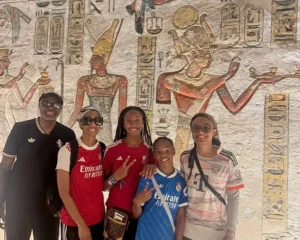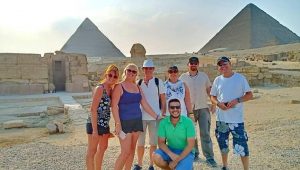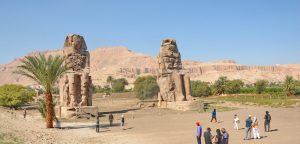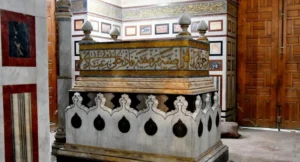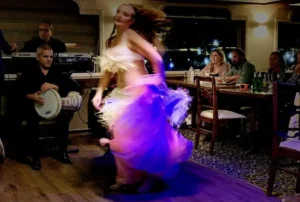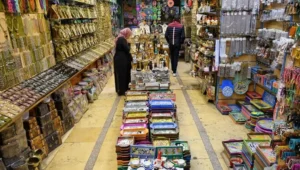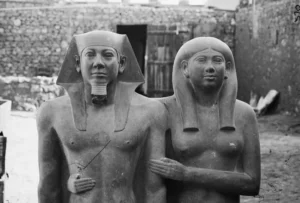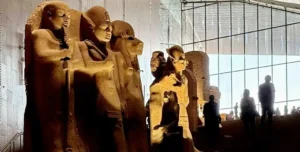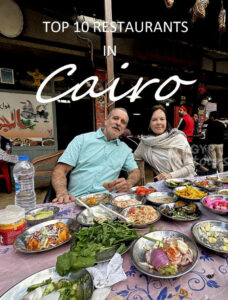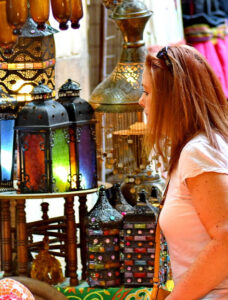Our long drive from Cairo turned into a terrifying flight through Alexandria’s impossibly crowded streets. Our minivan miraculously avoided hitting pedestrians, donkey carts, and old Lada cars. We arrived at the port gates with only 10 minutes to spare. But the guards ignored our U.S. passports, and they refused to let the van enter. We couldn’t argue with their badly oiled AK-47s. The grim possibility of spending a night or two in an Egyptian port city suddenly became real.
Our Journey Begins
Our adventure began harmlessly 36 hours earlier. The cruise ship, Crystal Serenity, floated into the oily waters of Alexandria harbor. It sailed past an endless line of tankers and freighters, a couple of rusted skeletons of sunken ships, and the Saracen Fort. This fort had sacrilegiously replaced Alexander’s lighthouse, the last and most modern wonder of the ancient world.
We were the first four people off the ship. We walked through a crowd of tour guides and bus drivers holding signs with various names. Our name wasn’t there. A phone call to the tour operator revealed that our driver lacked the necessary permits to enter the port. We had to hike across a long bridge to the outer gates.
A gray minibus with curtains over its windows waited for us. The port guards made us print our names and passport numbers. They also recorded our guides’ names. Then, they released us into a thick stew of people, cars, noise, smells, animals, and chaotic sounds.
The Mystery of the Minivan
Two local guides sat next to the driver. No one said a word. The scene was disturbing. We had so many questions: Why were the windows covered? Why did the guards record so much information about us and the guides? Why were there so many guides?
We knew that all the other tour buses from the cruise ship had a police escort. The official explanation was that the escort showed VIP treatment for Crystal Cruise Line’s valued passengers. However, we also knew that a week before our arrival, desert tribesmen had kidnapped a dozen tourists in Upper Egypt. Our imaginations ran wild.
One of the guides turned and looked at us. We could only imagine he was looking at us because he wore very large, dark sunglasses. “So, is this your first time in Egypt?” he asked slowly. He was tall and slender and spoke English carefully with a distinct Arabic accent. “My name is Mohammed. This is Yousef, and the driver is Ishaq. You are Americans, yes?”
Yes, we were Americans. It was our first time here. Why all this mystery about the curtains, guides, paperwork, and police escorts?
“Don’t worry,” Mohammed said with a laugh. “You can open the curtains. You will be perfectly safe here. Welcome to Egypt.” With these words, our minivan broke through the clogged streets and entered the Desert Highway.
A Ride Through the Desert
The desert looked bleak. We saw no picturesque dunes or camel caravans. Just mile after mile of yellowish, rocky void punctuated by military and police bases. As we approached Cairo, large farms replaced the military installations. The watchtowers transformed into tall white domes with multiple round openings.
“Pigeon homes,” Mohammed explained, pointing at the strange chimneys. “We grow them for food.” I decided not to share my opinion of pigeons as “rats with wings.”
Mohammed became more talkative during our first rest stop. He treated us to thick Turkish coffee at a roadside truck stop. He handed each couple a wad of Egyptian pounds. “Just until you get your own,” he said. Mohammed took a long drag from his cigarette. He told us a long story about finding a bride for a young man from Egypt who grew up in Queens. The search took a month and required extensive research. The groom wanted a bride who had not been circumcised at birth, a practice that still affects 95% of Muslim girls in Egypt.
First Glimpse of the Pyramids
After a three-hour drive, we entered Giza. It’s an enormous suburb of Cairo and home to some of the most astonishing monuments in human history. Our vehicle pulled into a guarded parking lot. Mohammed told us to put on our sunglasses and not give money to beggars. Then, we walked straight to the Great Pyramid of Giza.
The awe we felt was similar to our first encounters with the Eiffel Tower, the Colosseum, Big Ben, or the Brandenburg Gates. We had traveled for decades, but these monuments still moved us deeply. We had become battle-hardened travelers, used to seeing wonderful places. But nothing prepared us for this.
I’m not sure what shook us so much at the base of the Pyramids and the Great Sphinx. Was it their sheer magnitude? Was it the sudden realization that seven millennia of human history loomed over our heads? Or, was it the memory of our Soviet school geography textbook, which featured this exact picture on its cover?
Whatever the reason, it took Mohammed a lot of persuasion to get us away from the Giza Plateau. We had more driving to do and more amazing places to visit: Memphis, the ancient capital, and Saqqara with its Step Pyramid, the oldest known hewn-stone building.
Exhausted and full of emotions and historical trivia, we checked into our hotel. Then, we got ready for the nightly laser show next to the Great Sphinx.
Chaos in Cairo
Our second day in Cairo flew by. We spent just one hour in the massive historical museum. We walked by rows of mummified humans and animals. We admired King Tut’s golden death mask, sarcophagus, and countless artifacts not included in foreign exhibitions.
We visited the crowded Grand Bazaar and the stupendous Muhammad Ali mosque. However, nothing impressed us more than the skill required to drive a car in Cairo. Our minibus was constantly surrounded by suicidal crowds, unimaginable vehicles, and beasts of burden. It was a demolition derby. We saw a small pickup truck carrying four cows. Donkeys, horses, camels, and water buffaloes fought for every inch of the road with Ladas, Toyotas, motorbikes, and buses. In short, it was a madhouse!
The Dash to the Ship
Finally, we finished our sightseeing in Cairo. We faced the seemingly simple task of getting back to our ship in Alexandria. We had about five hours to cover a three-hour distance. We felt calm and happy about our Egyptian adventure.
As we neared Alexandria, the Desert Highway turned into chaotic streets. Traffic came to a complete halt in front of a new overpass. We still cheerfully commented on the horse and donkey carriages next to us. But we began looking at our watches more frequently. Even our driver and guide talked frequently in Arabic without bothering to translate. We were clearly in trouble. With just 30 minutes until the ship sailed, we started dialing the emergency numbers on our cruise passes.
No luck. The numbers were wrong, or our phones couldn’t connect. We tried calling Crystal’s port agent. “Please leave a voicemail message,” was all we heard.
Finally, our driver inched past a horse-drawn carriage and a broken-down army bus. A glimmer of hope appeared. What followed was a mad drive to the port and the standoff at its impenetrable gates.
Without wasting time, we said our goodbyes and thank yous. We grabbed our overnight bags and ran across the long bridge to the ship. The bridge was long, and our bags grew heavier with every step. But the ship was still there. This was extremely encouraging. We were greeted by smiling crew members and a stiff drink on our balcony. A glass of single-malt Scotch had never tasted so sweet!


